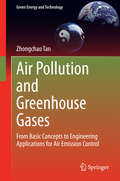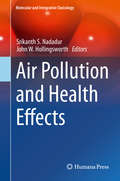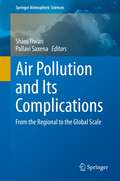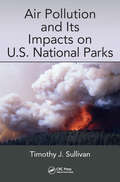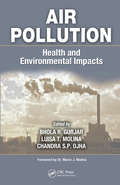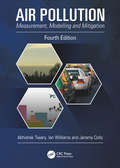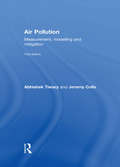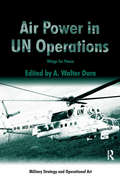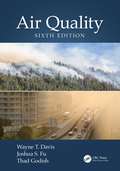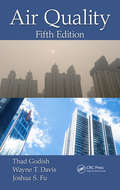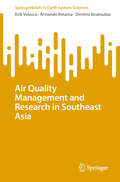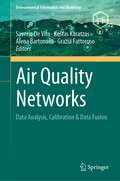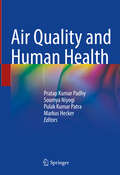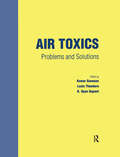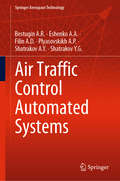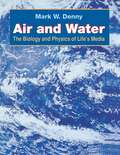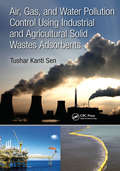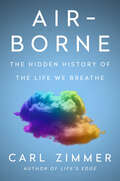- Table View
- List View
Air Pollution and Greenhouse Gases: From Basic Concepts to Engineering Applications for Air Emission Control (Green Energy and Technology)
by Zhongchao TanThis textbook discusses engineering principles relating to air pollution and greenhouse gases (GHGs); it focuses on engineering principles and designs of related devices and equipment for air emission control for a variety of industries such as energy, chemical, and transportation industries. The book aims primarily at senior undergraduate and graduate students in mechanical, chemical and/or environmental engineering departments; it can also be used as a reference book by technical staff and design engineers who are interested in and need to have technical knowledge in air pollution and GHGs. The book is motivated by recent rapid advances in air pollution and greenhouse gas emissions and their control technologies. In addition to classic topics related to air pollution, this book is also featured with emerging topics related to air pollution and GHGs. It covers recent advances in engineering approaches to the reduction of GHG emissions including, but are not limited to, green energy technologies and carbon sequestration and storage. It also introduces an emerging topic in air pollution, which is referred to as Nano Air Pollution. It is a growing concern in air pollution, but largely missing in similar books, likely because of recent rapid advances in nanotechnology has outpaced the advances in nano air pollution control.
Air Pollution and Health Effects (Molecular and Integrative Toxicology)
by Srikanth S. Nadadur John W. HollingsworthExposure to ambient air pollutants, both indoors and outdoors has been associated with the exacerbation and also in the etiology of diverse human diseases. This book offers an overview of our current understanding of air pollution health risks and how this knowledge is being used in the regulatory, therapeutic intervention measures to protect the public health and reduce the disease burden caused by acute and long-term exposure to air pollutants. Air Pollution and Health Effects provides readers with a comprehensive understanding of air pollution health risks, morbidity and the global disease burden, whilst also delivering critical review on state of the art research so as to gain a fundamental understanding of the biological mechanisms involved in the etiology of air pollution-induced diseases. Chapters range from pregnancy outcomes and pre-term birth, carcinogens in the ambient aerosol and the health consequences of indoor biomass burning. Special emphasis is placed on regional and local air pollution and its impact on global health along with suitable preventive and interventional measures. With contributions from international experts in the field this volume is a valuable guide for researchers and clinicians in toxicology, medicine and public health as well as industry and government regulatory scientists involved in health protection.
Air Pollution and Its Complications: From the Regional to the Global Scale (Springer Atmospheric Sciences)
by Pallavi Saxena Shani TiwariThis book provides an overview of the fundamental concept of air pollution, emission sources of air pollutants and their transportation.First, the book presents a brief background on air pollution and its emission sources, then it continues with their impact on agriculture, health, and climate change. Furthermore, it covers the basic concepts of air pollution, transportation of air pollutants, global climate change and the use of science in air pollution policy formulation in detail. It also emphasizes the effects of air pollutants in altering the onset pattern of the Indian Summer Monsoon. In addition, it describes the impacts of air pollution on the cryosphere and human health.In this book the editors provide an interdisciplinary unique collection of new studies and findings on the groove of air pollution, to improve the basic understanding of graduate students as well as researchers in the field of air pollution and its impacts on various aspects of the atmosphere and surroundings. This collection covers the basic concepts of air pollution, transportation of air pollutants, and global climate change and the use of science in air pollution policy formulation.
Air Pollution and Its Impacts on U.S. National Parks
by Timothy J. SullivanA variety of air pollutants are emitted into the atmosphere from human-caused and natural emissions sources throughout the United States and elsewhere. These contaminants impact sensitive natural resources in wilderness, including the national parks. The system of national parks in the United States is among our greatest assets. This book provides a compilation and synthesis of current scientific understanding regarding the causes and effects of these pollutants within national park lands. It describes pollutant emissions, deposition, and exposures; it identifies the critical (tipping point) loads of pollutant deposition at which adverse impacts are manifested.
Air Pollution and the Electromagnetic Phenomena as Incitants (Electromagnetic Frequency Sensitivities)
by William J. ReaThe field of electromagnetic sensitivity is the new epidemic of the 21st century, and can cause disease of the automatic nerve system in any part of the body. This is as a result of chemical sensitivity, in which over 80,000 chemicals are involved, resulting in innumerable combinations. A cursory understanding of the combinations can help clinicians partially understand the associated problems and thus help in the diagnosis and treatment of electromagnetic sensitivities. But a basic understanding of environmentally induced illness and healing must first be understood by the clinicians before diseases occur such as cardiac arrhythmia, muscle spasms, and nerve pain.
Air Pollution in Eastern Asia: An Integrated Perspective (ISSI Scientific Report Series #16)
by Xuemei Wang Idir Bouarar Guy P. BrasseurThis book, written by an international group of experts from China, Europe and the USA, presents a broad and comprehensive analysis of the chemical and meteorological processes responsible for the formation of air pollutants in eastern Asia, and in particular for the development of severe pollution episodes observed primarily during winter in the northeastern part of China. With the rapid population growth, economic development and urbanization occurring in Asia, air pollution has become a major environmental problem in this part of the world. The book is organized around six distinct parts. The first part of the volume offers a general perspective on issues related to air pollution including persistent haze events in eastern and southern Asia. The second part presents an overview of air pollution sources (i. e. , anthropogenic and biomass burning sources). The third part analyzes in-situ observations of chemical species in China, while the fourth part focuses on space observations of gas-phase and aerosol species. The modeling aspects are treated in the fifth part of the volume, which includes a presentation of several air quality forecast systems and an assessment of the role of urbanization on air pollution levels. Finally, the effects of air pollution on health and crop productivity in China are discussed in the last part of the book. The book also presents an integrated view of past and present situations in Asia and provides the scientific basis from which mitigation policies can be established and air quality can be improved. Audience: This book is written for scientists, educators, students, environmental managers, policy-makers and leaders in public administration and private corporations who wish to use science-based information to mitigate air pollution. The book should help decision-makers to design effective policies for air quality improvement and to successfully manage short-term air pollution episodes that substantially affect people's quality of life and strongly impact the economy.
Air Pollution: Health and Environmental Impacts
by Luisa T. Molina Bhola R. Gurjar Chandra S. P. OjhaAir pollution is recognized as one of the leading contributors to the global environmental burden of disease, even in countries with relatively low concentrations of air pollution. Air Pollution: Health and Environmental Impacts examines the effect of this complex problem on human health and the environment in different settings around the world. I
Air Pollution: Measurement, Modelling and Mitigation (4th Edition)
by Ian Williams Abhishek TiwaryThis established textbook offers a one-stop, comprehensive coverage of air pollution, all in an easy-reading and accessible style. The fourth edition, broadly updated and developed throughout, includes a brand-new chapter providing a broader overview to the topic for general reading, and presents fresh materials on air pollution modelling, mitigation and control, tailored to the needs of both amateur and specialist users. Retaining a quantitative perspective, the covered topics include: gaseous and particulate air pollutants, measurement techniques, meteorology and modelling, area sources, mobile sources, indoor air, effects on plants, materials, humans and animals, impact on climate change and ozone profiles and air quality legislations. This edition also includes a final chapter covering a suite of sampling and laboratory practical experiments that can be used for either classroom teachings, or as part of research projects. As with previous editions, the book is aimed to serve as a useful reading resource for upper-level undergraduate and postgraduate courses specialising in air pollution, with dedicated case studies at the end of each chapter, as well as a list of revision questions provided at the end as a complementary section.
Air Pollution: Measurement, Modelling and Mitigation, Third Edition
by Jeremy Colls Abhishek TiwaryA one stop, comprehensive textbook, covering the three essential components of air pollution science. The Third Edition has been updated with the latest developments, especially the inclusion of new information on the role of air pollutants in climate change. The authors give greater coverage to the developing economies around the world where air pollution problems are on the rise. The Third Edition continues to cover a wide range of air quality issues, retaining a quantitative perspective. Topics covered include - gaseous and particulate air pollutants, measurement techniques, meteorology and dispersion modelling, mobile sources, indoor air, effects on plants, materials, humans and animals. Moving away from classical toxic air pollutants, there is a chapter on climate change and another on the depletion of stratospheric ozone. A special feature of this new edition is the inclusion of a fresh chapter on air pollution mitigation by vegetation, mainly its role in maintaining a sustainable urban environment. Recommended for upper-level undergraduate and postgraduate courses specialising in air pollution, both for environmental scientists and engineers. The new material included in the Third Edition extends its use by practitioners in consultancies or local authorities.
Air Power in UN Operations: Wings for Peace (Military Strategy and Operational Art)
by A. Walter DornAir power for warfighting is a story that's been told many times. Air power for peacekeeping and UN enforcement is a story that desperately needs to be told. For the first-time, this volume covers the fascinating range of aerial peace functions. In rich detail it describes: aircraft transporting vital supplies to UN peacekeepers and massive amounts of humanitarian aid to war-affected populations; aircraft serving as the 'eyes in sky' to keep watch for the world organization; and combat aircraft enforcing the peace. Rich poignant case studies illuminate the past and present use of UN air power, pointing the way for the future. This book impressively fills the large gap in the current literature on peace operations, on the United Nations and on air power generally.
Air Purifier: Property, Assessment and Applications
by Zhonglin XuThis book discusses the development, types and application principles of portable air purifiers in China. It analyzes the theoretical characteristics of air purifiers under various operational conditions, and points out that the term “Clean Air Delivery Rate” cannot be used to precisely reflect the problems that occur under various operational conditions. By comparing theoretical and measured data, it highlights the mainfeatures of air purifiers and key points in the design process for different applications. Calculation methods for the indoor particle concentration and the self-purification time are also provided. The book describes the conditions for window opening in smog and for selecting air purifiers, and proposes a newmethod for improvingtheir measurement. In closing, it includes a new assessment index.
Air Quality
by Joshua S. Fu Wayne T. DavisThe sixth edition of a bestseller, Air Quality provides students with a comprehensive overview of air quality, the science that continues to provide a better understanding of atmospheric chemistry and its effects on public health and the environment, and the regulatory and technological management practices employed in achieving air quality goals. Maintaining the practical approach that has made previous editions popular, the chapters have been reorganized, new material has been added, less relevant material has been deleted, and new images have been added, particularly those from Earth satellites. New in the Sixth Edition New graphics, images, and an appended list of unit conversions New problems and questions Presents all-new information on the state of air quality monitoring Provides the latest updates on air quality legislation in the United States Updates the effects of air pollution and CO2 on climate change Examines the effects of the latest changes in energy production and the related emissions and pollutants Offers broadened coverage of air pollutant emissions and air quality in a global context This new edition elucidates the challenges we face in our efforts to protect and enhance the quality of the nation’s air. It also highlights the growing global awareness of air quality issues, climate change, and public health concerns in the developing world. The breadth of coverage, review questions at the end of each chapter, extensive glossary, and list of readings place the tools for understanding into your students’ hands.
Air Quality
by Thad Godish Joshua S. Fu Wayne T. DavisThe fifth edition of a bestseller, Air Quality provides students with a comprehensive overview of air quality, the science that continues to provide a better understanding of atmospheric chemistry and its effects on public health and the environment, and the regulatory and technological management practices employed in achieving air quality goals.
Air Quality Management and Research in Southeast Asia (SpringerBriefs in Earth System Sciences)
by Erik Velasco Armando Retama Dimitris StratouliasThis book examines the capabilities for monitoring air quality, developing emission inventories, and running chemical-transport models for regulatory, forecasting, and research purposes in Southeast Asia. It also reviews scientific efforts made to better understand and characterize air pollution in the region. Poor air quality poses a threat to public health. It affects people's lives and undermines economic growth, but as in many other parts of the world, it has been overlooked in Southeast Asia. International assessments suggest that it is the culprit of 260-thousand premature deaths in the region each year, entailing a monetary cost equivalent to 6.75% of the regional GDP. Reducing air pollution requires concerted efforts from all Southeast Asian nations to implement local and regional air quality policies following a science-policy approach. For such endeavor, it is essential to develop tools that enable timely and reliable air quality management. This entails collecting data to characterize the magnitude, origin, and impact of air pollution to support corrective actions. The objective of this book is to provide a starting point for a science-based conversation about implementing solutions to Southeast Asia's air pollution problem by bringing together an analysis of the availability of air quality data and studies from across the region.
Air Quality Networks: Data Analysis, Calibration & Data Fusion (Environmental Informatics and Modeling)
by Kostas Karatzas Saverio De Vito Alena Bartonova Grazia FattorusoThis volume offers expert contributions proposing new and recently set scientific standards for smart air quality (AQ) networks data processing, along with results obtained during field deployments of pervasive and mobile systems. The book is divided into 5 main sections; 1) future air quality networks, 2) general data processing techniques, 3) field deployments performances, 4) special applications, and 5) cooperative and regulatory efforts. The authors offer different sources of data for the production of trustworthy insights, including spatio-temporal predictive AQ maps meant to boost citizen awareness, and informed participation in remediation and prevention policies. Readers will learn about the best and most up-to-date practices for measuring and assessing air quality, while also learning about current regulatory statuses regarding air quality technology design and implementation. The book will be of interest to air quality regulatory agencies, citizen science groups, city authorities, and researchers and students working with air quality sensors and geostatistics.
Air Quality and Human Health
by Markus Hecker Pratap Kumar Padhy Soumya Niyogi Pulak Kumar PatraThe book is one of the outcomes of the SPARC (Scheme for Promotion of Academic and Research Collaboration) project titled "Fine particulates matters in the air environment and their cancer risks in human beings," sponsored by MHRD (now MoE), Govt. of India. The editors of the book are PIs and Co-PIs of the said project. The text deliberates on air pollution's health risks with contributions from well-known experts from diverse research fields (environmental science, toxicology, geology, public health science, biology, physics, chemistry, and geospatial technology). It explores it its control and mitigation strategies. The book provides an up-to-date overview of the modern methods and tools used in air quality monitoring and human health risk assessment. Case studies from different global settings offer invaluable insights into air pollution-related regional health issues. It addresses all aspects of air quality, covering indoor-outdoor air pollution, gaseous and particulate pollutants; characterization of source and pathways of air pollutants; and the modeling and assessing of health risks (respiratory, epidemiological, and toxicological) with regional and global perspectives. It also addresses air quality management issues. The lucid explanation of the role of oxidative stress mechanisms and molecular biomarkers (genomics, proteomics) may be considered as inputs into the development of cancer therapeutics. Along with providing a scientific basis for air pollution, this book will help readers appreciate the environmental determinants of public health and apply research evidence to improve the quality of life. It also delineates future research initiatives and policy actions needed to protect human health from air pollution, locally and globally. The book will be of great educational value and help for consultation and teaching.
Air That Kills: India's Pollution Problem (Fountas & Pinnell Classroom, Guided Reading Grade 5)
by Susan StubbsTOXIC AIR In some Indian cities, people hurry through the streets, gasping for air. They have trouble breathing because of the air pollution, which is so bad that it can cause illness, and even death. NIMAC-sourced textbook
Air Toxics: Problems and Solutions
by Kumar GanesanThis timely new workbook is the result of a year-long effort by a group of university professors who first met at Montana Tech during the summer of 1994 for a college faculty workshop. The workshop was funded by the National Science Foundation's support for those faculty developing courses in the newly emerging field of air toxics. Part I of the book contains over 100 problems dealing with a variety of topics in this area. Part II provides detailed solutions. The problems and solutions provided will become a useful resource for the training of engineers and scientists who are or soon will be working in the field.
Air Traffic Control Automated Systems (Springer Aerospace Technology)
by Shatrakov A.Y. Shatrakov Y.G. Bestugin A.R. Eshenko A.A. Filin A.D. Plyasovskikh A.P.This book highlights operation principles for Air Traffic Control Automated Systems (ATCAS), new scientific directions in design and application of dispatching training simulators and parameters of ATCAS radio equipment items for aircraft positioning. This book is designed for specialists in air traffic control and navigation at a professional and scientific level. The following topics are also included in this book: personnel actions in emergency, including such unforeseen circumstances as communication failure, airplane wandering off course, unrecognized aircraft appearance in the air traffic service zone, aerial target interception, fuel draining, airborne collision avoidance system (ACAS) alarm, emergency stacking and volcanic ash cloud straight ahead.
Air and Water: The Biology and Physics of Life's Media
by Mark W. DennyAddressing general readers and biologists, Mark Denny shows how the physics of fluids (in this case, air and water) influences the often fantastic ways in which life forms adapt themselves to their terrestrial or aquatic "media."
Air and Weather
by Lawrence Hall of Science University of California at BerkeleyNIMAC-sourced textbook
Air and Weather
by Lawrence Hall of Science University of California at BerkeleyNIMAC-sourced textbook
Air, Gas, and Water Pollution Control Using Industrial and Agricultural Solid Wastes Adsorbents
by Tushar SenAir and water pollution occurs when toxic pollutants of varying kinds (organic, inorganic, radioactive and so on) are directly or indirectly discharged into the environment without adequate treatment to remove these potential pollutants. There are a total of 13 book chapters in three sections contributed by significant number of expert authors around the world, aiming to provide scientific knowledge and up-to-date development of various solid wastes based cost-effective adsorbent materials and its sustainable application in the removal of contaminates/pollutants from air, gas and water. This book is useful for the professions, practicing engineers, scientists, researchers, academics and undergraduate and post-graduate students’ interest on this specific area. Key Features: • Exclusive compilation of information on use of industrial and agricultural waste based adsorbents for air and water pollution abatement. • Explores utilization of industrial solid wastes in adsorptive purification and agricultural and agricultural by-products in separation and purification. • Discusses cost-effective solid wastes based emerging adsorbents. • Alternative adsorbents in the removal of a wide range of contaminants and pollutants from water is proposed. • Includes performance of unit operations in waste effluents treatment.
Air-Borne: The Hidden History of the Life We Breathe
by Carl ZimmerThe fascinating, untold story of the air we breathe, the hidden life it contains, and invisible dangers that can turn the world upside downEvery day we draw in two thousand gallons of air—and thousands of living things. From the ground to the stratosphere, the air teems with invisible life. This last great biological frontier remains so mysterious that it took over two years for scientists to finally agree that the Covid pandemic was caused by an airborne virus.In Air-Borne, award-winning New York Times columnist and author Carl Zimmer leads us on an odyssey through the living atmosphere and through the history of its discovery. We travel to the tops of mountain glaciers, where Louis Pasteur caught germs from the air, and follow Amelia Earhart and Charles Lindbergh above the clouds, where they conducted groundbreaking experiments. We meet the long-forgotten pioneers of aerobiology including William and Mildred Wells, who tried for decades to warn the world about airborne infections, only to die in obscurity.Air-Borne chronicles the dark side of aerobiology with gripping accounts of how the United States and the Soviet Union clandestinely built arsenals of airborne biological weapons designed to spread anthrax, smallpox, and an array of other pathogens. Air-Borne also leaves readers looking at the world with new eyes—as a place where the oceans and forests loft trillions of cells into the air, where microbes eat clouds, and where life soars thousands of miles on the wind.Weaving together gripping history with the latest reporting on Covid and other threats to global health, Air-Borne surprises us on every page as it reveals the hidden world of the air.
